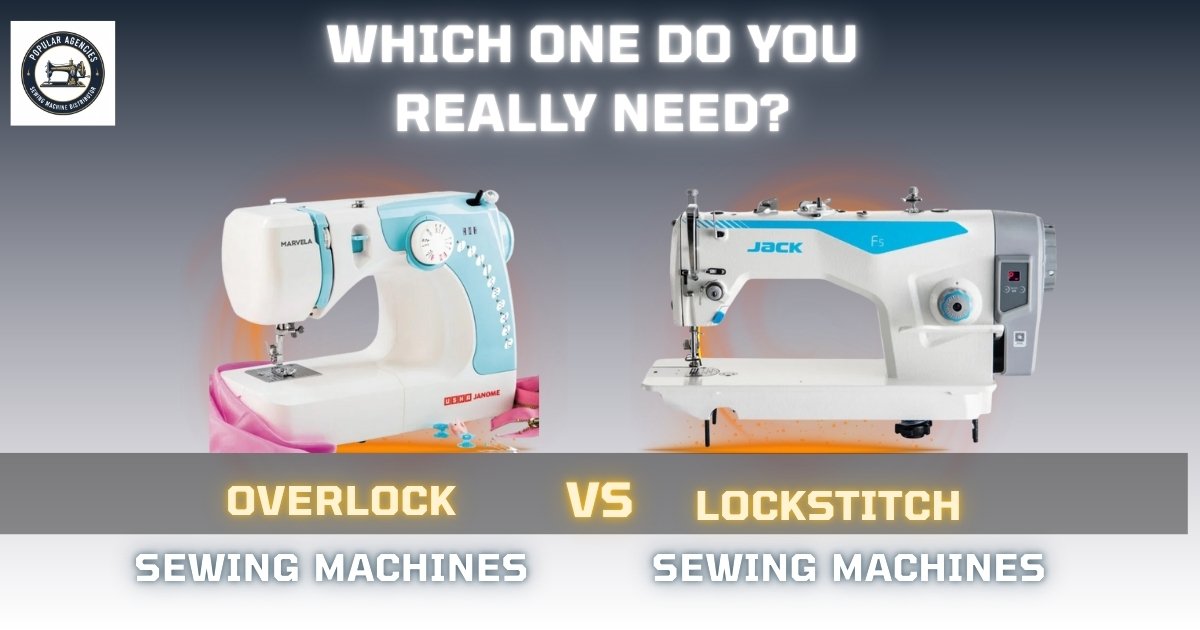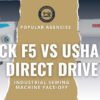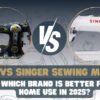Overlock vs Lockstitch Machines – Which One Do You Really Need?

If you’re setting up a tailoring shop or a small garment unit, one of the biggest confusions you’ll face is choosing between Overlock and Lockstitch sewing machines. Both are essential in the garment industry, but they serve very different purposes.
While lockstitch machines create strong, straight seams for general stitching, overlock machines handle the finishing touches — trimming fabric edges and preventing fraying. To build an efficient setup, it’s important to understand what each machine does, how they differ, and which one best fits your stitching needs.
Let’s dive into the Overlock vs Lockstitch comparison and make it simple for you to decide.
1. What Is a Lockstitch Machine?
A lockstitch machine is the most common type of sewing machine used worldwide. It uses two threads — one from the needle and one from the bobbin — that “lock” together in the middle of the fabric to form a strong, durable stitch.
These machines are ideal for:
- Straight stitching
- Joining fabric panels
- Topstitching and hemming
- General garment construction
Examples include models like Jack F5, Usha S2 Direct Drive, or Singer Merritt Tailor, which are built for precise, professional stitching.
Key Features:
- Uses two threads (needle + bobbin).
- Produces a straight, neat stitch.
- Suitable for most types of fabrics.
- Commonly used in tailoring shops and factories.
2. What Is an Overlock Machine?
An overlock machine, also known as a serger, is designed for edge finishing. It trims the fabric edge and simultaneously wraps it with thread loops to prevent fraying. Overlockers can use 3, 4, or 5 threads, depending on the model, and they produce the stretchy, finished seams often seen inside T-shirts or knitwear.
These machines are perfect for:
- Edge finishing and seam sealing
- Knitwear and stretchy fabrics
- Professional garment finishing
- Decorative edging on dresses or home textiles
Brands like Jack, Revo, and Brother make reliable overlock models that combine speed with fine finishing.
Key Features:
- Uses 3–5 threads.
- Cuts and stitches simultaneously.
- Prevents fraying and gives a clean finish.
- Ideal for woven and stretch fabrics.
3. Structural Difference – How They Stitch
| Feature | Lockstitch Machine | Overlock Machine |
|---|---|---|
| Thread System | 2 threads (needle & bobbin) | 3–5 threads (loopers & needles) |
| Stitch Type | Straight stitch | Overcast stitch |
| Fabric Edge Trimming | No | Yes, built-in knife trims edges |
| Elasticity | Less stretch | More stretch (good for knits) |
| Application | Construction stitching | Edge finishing |
In short:
- Lockstitch = Strength + Durability
- Overlock = Finishing + Flexibility
4. Performance & Speed
In industrial setups, speed and accuracy matter most.
- Lockstitch machines like the Jack F5 or Usha S2 can deliver up to 5000 stitches per minute, making them ideal for high-volume production of shirts, pants, and uniforms.
- Overlock machines, while slightly slower (3500–4500 SPM), handle edge trimming and seam sealing in one go, saving time during finishing.
So, while the lockstitch may seem faster, the overlock reduces additional finishing steps — balancing efficiency in a different way.
5. Fabric Compatibility
| Fabric Type | Recommended Machine | Reason |
|---|---|---|
| Cotton, linen, polyester | Lockstitch | Clean, firm seams |
| Knitwear, jersey, stretch fabrics | Overlock | Stretchy, flexible seams |
| Denim, canvas | Lockstitch | Strong structural seams |
| Light silk or chiffon | Overlock (3-thread) | Prevents fraying on delicate edges |
Verdict:
If you mainly work with woven fabrics, the lockstitch machine is your foundation. If your projects involve stretchy or delicate materials, an overlock machine becomes essential.
6. Stitch Appearance & Function
Lockstitch Output
Produces a tight, flat seam with identical appearance on both sides. Perfect for visible stitching like top hems, collars, and straight joins.
Overlock Output
Creates a looped edge seam that wraps around the fabric edge. The stitch looks different on front and back but gives a smooth, elastic finish.
Pro Tip:
Garment manufacturers often use both — lockstitch for main seams and overlock for finishing edges — for the best results.
7. Maintenance & Ease of Use
- Lockstitch Machines: Easier to thread and maintain; ideal for beginners and general tailoring.
- Overlock Machines: Slightly complex threading (especially 4 or 5-thread versions) but deliver professional finishing once mastered.
Both require oiling, cleaning lint, and adjusting tension occasionally — but modern models like Jack F4/F5 (lockstitch) and Jack E4 (overlock) are designed with self-lubrication and LED work lights for convenience.
8. Pricing Comparison
| Machine Type | Price Range (Ex-GST) | Typical Use |
|---|---|---|
| Lockstitch | ₹18,000 – ₹25,000 | Garment assembly, straight stitching |
| Overlock | ₹22,000 – ₹30,000 | Edge finishing, knitwear production |
Though slightly more expensive, overlock machines save time during finishing — which can translate into higher productivity and profit for professional tailors.
9. Which One Should You Choose?
Your choice depends on your type of work:
| User Type | Recommended Machine | Reason |
|---|---|---|
| Boutique Tailor | Lockstitch + Overlock | Both essential for quality finishing |
| Garment Factory | Overlock + Lockstitch | Combination ensures fast production |
| Home Tailor | Lockstitch | Affordable and easy to use |
| Knitwear Designer | Overlock | Handles stretch fabrics perfectly |
| Alteration Shop | Lockstitch | Works for hemming and repairs |
For most professional setups, having one of each is the ideal combination — the lockstitch builds the garment, and the overlock refines it.
10. Final Verdict
Both lockstitch and overlock sewing machines are crucial in tailoring and garment manufacturing. They don’t compete — they complement each other.
- Choose Lockstitch for durable seams, topstitching, and structure.
- Choose Overlock for finishing edges, preventing fraying, and stretchable seams.
If you’re setting up a new tailoring unit or upgrading your equipment, consider starting with a lockstitch machine like the Jack F5 or Usha S2, and then add an overlock machine like Jack E4 or Revo 747 for finishing.
Categories
- Sewing Machines (9)
- Uncategorized (2)
News
Newsletter
Frequently Asked Questions
Can I use an overlock machine for normal stitching?
No, overlock machines are meant for edge finishing, not for constructing garments. You still need a lockstitch machine for the main stitching.
Do lockstitch machines trim fabric edges automatically?
No. Only overlock machines have built-in knives to trim fabric edges during stitching.
Which is better for T-shirt stitching – overlock or lockstitch?
Overlock machines are ideal for knitwear like T-shirts because they create stretchable seams that don’t break.
Can beginners use overlock machines easily?
Yes, modern overlock machines are easy to use once you learn threading and tension control.
Do I need both overlock and lockstitch machines in my tailoring shop?
If you want professional results and durable garments, yes — both machines are essential for a complete setup.








Add comment